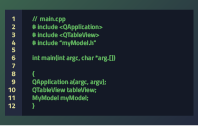Coding

- Writing Code
Writing, editing, and navigating in source code are core tasks in application development. Therefore, the code editor is one of the key components of Qt Creator. You can use the code editor in the Edit mode.
- Finding
Use the incremental and advanced search to search from currently open projects or files on the file system or use the locator to browse through projects, files, classes, functions, documentation and file systems.
- Refactoring
Code refactoring is the process of improving and simplifying code without modifying the existing functionality of an application. You can easily find and rename symbols and apply predefined actions to refactor code.
- Beautifying Source Code
Beautifying code means applying indentation and style to source code files. You can use the Artistic Style, ClangFormat, or Uncrustify tool to format source files.
- Configuring the Editor
You can change the fonts, colors, highlighting, and indentation. If you are used to the Vim editor, you can even run the main editor in a manner similar to it in the FakeVim mode.
Related Topics
- Using Language Servers
The language client offers code completion, highlighting of the symbol under cursor, and jumping to the symbol definition for other programming languages besides C++. In addition, it integrates diagnostics from the language server.
- Editing MIME Types
Qt Creator uses the MIME type of a file to determine which mode and editor to use for opening the file. If your files do not match the predefined MIME types, you can edit the MIME types.
- Modeling
You can use the model editor to create Universal Modeling Language (UML) style models with structured and behavioral diagrams that show your system in many ways and store them in XML format.
- Editing State Charts
You can use Qt Creator to create applications that embed state machines. A project wizard creates State Chart XML (SCXML) files with boilerplate code that you can edit using an experimental SCXML editor. You can use the classes in the Qt SCXML module to embed state machines created from the files in Qt applications.
© 2023 The Qt Company Ltd. Documentation contributions included herein are the copyrights of their respective owners. The documentation provided herein is licensed under the terms of the GNU Free Documentation License version 1.3 as published by the Free Software Foundation. Qt and respective logos are trademarks of The Qt Company Ltd in Finland and/or other countries worldwide. All other trademarks are property of their respective owners.